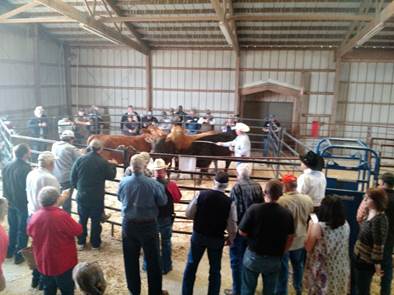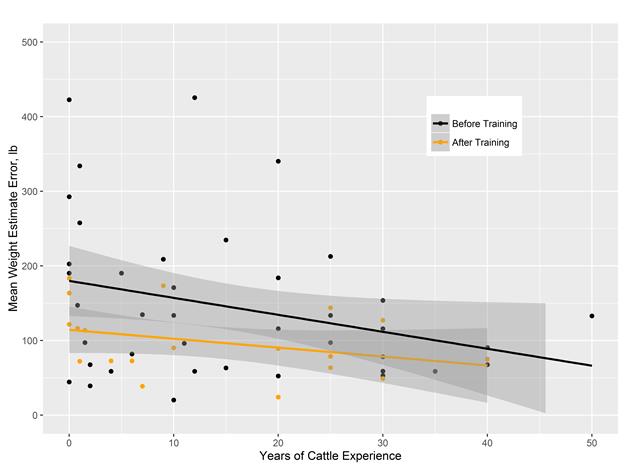 |
October 2017
|
October 2017 // Volume 55 // Number 5 // Ideas at Work // v55-5iw3
Using Gamification to Teach Livestock Management Skills
Abstract
This article describes a game that is based around estimating body weights of live cows and is used for teaching ranchers about the importance of monitoring the body weights of their animals. Ranchers viewed four cows and then used their smartphones to submit an estimate of each cow's weight. Results were accumulated and analyzed through use of a custom software script and then were shared with the ranchers during a training session. Following training, the ranchers evaluated four additional cows. Participating in and engaging with the game and training significantly improved ranchers' skill at estimating weight. Gamification can be a useful approach when interacting with and educating ranchers.
Introduction
The concept of gamification—incorporating game-like elements into traditionally nongame activities—has been a topic of recent discussion in the educational environment (Hamari, Koivisto, & Sarsa, 2014). The purpose of using gamification is to improve educational value by increasing engagement among students. Researchers have evaluated the use of gamification in educating the public about agriculture sustainability issues (Muhkerjee, 2014) and nutrition (Schuster, 2012), but a search for references to using gamification to improve the delivery of livestock education to ranchers yielded no results. Consequently, I explored the idea of using gamification to teach livestock management skills to ranchers. I chose to focus on the useful skill of estimating live body weights of cows because many ranchers tend to subconsciously prefer large animals and the associated expected increases in growth (D. Lalman, personal communication, February 2, 2016), even though larger animals require additional feed (National Research Council, 2000). Measuring weight by weighing cattle on scales is optimal, but for many ranchers, actually weighing cattle prior to making management decisions is too time-consuming, laborious, or expensive. Further, many ranchers take pride in being able to estimate cow weight visually, which I hypothesized would increase their willingness to engage in the game.
Methods
I conducted the gamification project during a 45-min presentation at a traditional beef cattle Extension meeting in eastern Oklahoma in April 2016. Approximately 150 beef cattle ranchers were in attendance. The ranchers were briefly introduced to the purpose and procedures of the game through a slide presentation and then were instructed in how to participate in the game by using their smartphones. The instructions indicated that ranchers would use a link provided to them to access a Google Form in which they would enter data related to the game. The objective of the game was to visually estimate individual body weights of live cows. Having weighed the cows 2-3 hr prior to the game, I knew their actual body weights. I instructed the ranchers to view four cows (Set 1) in a small pen and submit their best estimates of the cows' body weights (Figure 1). I also asked the ranchers to indicate how many years they had been managing cattle.
Figure 1.
Ranchers Participating in a Game by Estimating Live Body Weights of Cows

Ranchers had approximately 10 min to view the cattle and submit their data. Data were then analyzed through use of a custom script in R (R Core Team, 2016). Data cleaning involved the use of simple algorithms to remove outliers, such as weights that were not realistic and may have represented either data entry errors or the work of mischievous participants. Histograms of the participants' weight estimates for the cows were displayed and discussed with the group (an example histogram is shown in Figure 2). Between discussions of the histograms, educational material was presented to help ranchers improve their weight estimation skills and understand the nutritional and economic implications of increased cow body weight. Following this review of data and educational presentation, the ranchers evaluated an additional four live cows (Set 2). Histograms of the ranchers' body weight estimates for these cows were then presented, highlighting the improvement in their estimates. This part of the project took approximately 15 min.
Figure 2.
Example of Histogram Presented to Ranchers Showing Real-Time Data About Their Estimates of a Cow's Body Weight

Results and Discussion
Forty-two ranchers submitted body weight estimates for the initial four cows (Table 1). Mean weight estimate error for a given participant across the four cows was 144 lb. At least 23 ranchers submitted data for the second set of cows. When ranchers played the game again, estimating the body weights of a second set of cows following the review of the data from Set 1 and the educational presentation, the mean error for the second set of cows was only 100 lb. This difference represented an improvement of ranchers' weight estimation skills of 31%.
| Cow | Actual body weight, lb | n | Body weight estimates, lb | |||
| M | Min | Max | SD | |||
| 1 | 1,271 | 42 | 1,205 | 750 | 1,650 | 189.8 |
| 2 | 988 | 42 | 1,040 | 690 | 1,490 | 168.4 |
| 3 | 1,211 | 42 | 1,148 | 700 | 1,713 | 202.8 |
| 4 | 1,041 | 42 | 1,048 | 680 | 1,450 | 171.5 |
| 5 | 1,108 | 24 | 1,207 | 925 | 1,431 | 123.2 |
| 6 | 1,234 | 23 | 1,249 | 1,100 | 1,400 | 87.6 |
| 7 | 1,013 | 24 | 1,057 | 850 | 1,400 | 137.9 |
| 8 | 1,226 | 23 | 1,169 | 975 | 1,350 | 102.6 |
The cattle management experience of the ranchers ranged from 0 to 50 years (M = 15.8 years). Mean error for estimates made before the training (Set 1) was negatively associated with years of experience. The slope coefficient from a linear regression was −2.27 (p = .048), indicating that mean error decreased by 2.27 lb for each year of experience managing cattle (Figure 3). The slope from the regression of the Set 2 data (after training) was −1.19 (p = .156). This difference can be interpreted to mean that the weight estimation game and associated training helped ranchers "jump start" their weight estimation skills rather than having to rely on years of experience alone to develop such skills. The intercept of the equations (representing 0 years of experience) decreased from 180 lb before the training to 114 lb after the training. Thus, participating in the game and training was equivalent to gaining 29 years of cattle management experience with regard to developing weight estimation skills ([interceptSet 1 – interceptSet 2] / slopeSet 1). Explaining to the ranchers these improvements in their performance seemed to generate excitement and help cement the concepts that had been presented.
Figure 3.
Regression of Mean Error of Body Weight Estimates on Years of Cattle Management Experience for Ranchers Participating in Cow Weight Estimation Game

Beyond the fun of testing their skills in a particular area, ranchers may experience some real benefits from gamified Extension programs, including increased retention of the educational material and increased confidence in their management skills. I observed that ranchers were more willing to ask questions and participate in discussion because of the game. In addition, gamification may increase engagement and satisfaction among educators and could provide data to better quantify impact. These benefits would be transferrable to almost any activity in which a new skill or concept is taught (agronomy, home economics, etc.). However, the technical skill needed to design and implement game algorithms may be a challenge for some educators. Moreover, although 68% of adults in the United States own smartphones (Anderson, 2015), the technical savvy of audiences may limit the applicability of this approach. However, the project reported herein demonstrated that gamification is feasible.
Implications
Gamification was successfully implemented in a traditional rancher education environment. Participants were able and willing to submit data during the game electronically and were receptive to the game format. The format generated greater presenter–audience discussion and interaction than is typical in traditional slideshow format presentations. This approach has potential value, and Extension educators should consider incorporating it in their repertoires.
References
Anderson, M. (2015). Technology device ownership: 2015. Retrieved from http://www.pewinternet.org/2015/10/29/technology-device-ownership-2015
Hamari, J., Koivisto, J., & Sarsa, H. (2014). Does gamification work? A literature review of empirical studies on gamification. 47th Hawaii International Conference on System Sciences, Waikoloa, HI, pp. 3025–3034. doi:10.1109/HICSS.2014.377
Muhkerjee, R. (2014). DairyTale: Gamification as a means to raise awareness of sustainability. Master of Design, College of Creative Arts, Massey University, Wellington, New Zealand. Retrieved from https://oatd.org/oatd/search?q=DairyTale&form=basic
National Research Council. (2000). Nutrient requirements of beef cattle (7th ed.). Washington, DC: National Academies Press.
Schuster, E. (2012). Mobile learning and the visual web, oh my! Nutrition education in the 21st century. Journal of Extension, 50(6), Article 1COM1. Available at: https://www.joe.org/joe/2012december/comm1.php




